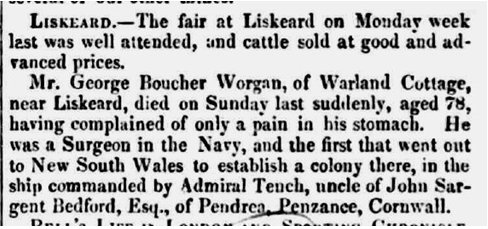|
FF George BouchierWorganSurgeon
‘HMS Sirius’(1757–1838)
this story is under review by Membership Team
George BouchierWorgan was baptized at St
Andrew’s, Holburn, London on 3 May 1757, son of John and
Sarah Worgan. His father John was a doctor of music.
George joined the navy as a surgeons mate in 1778 and
served on HMS Pilotefor 2 years, 3 months and one
week until June 1782.
In 1786 he was discharged from the
position of surgeons’ first mate aboard the Portsmouth
guard ship Ganges to Sirius on 1 November
and sailed with her as the ship’s surgeon in the First
Fleet.
Worgan seems to have been an amiable,
cultured and good natured young man whose company was
enjoyed by his fellow officers and Elizabeth Macarthur
regretfully notes his departure for England.
I assure you in losing him (Mr Worgan), a
very considerable branch of our society will be lopp’d
off.
The surgeon was distinguished in
contemporary memoirs by having taken his piano with him
of Sirius. On 7 August 1787 when the Fleet lay at
Rio, Surgeon Bowes received an invitation to dine with
Worgan& to hear his Piano Forte: he is a Son of Dr
Wogan D: Music: & seems a very sensible good kind of
man. Bowes, Major Ross and Surgeon John White went
again to hear the music on 20 August.
George Worgan left an account of the
first few months in the colony written as letters to his
brother Richard. His descriptions of plants and animals
in the area as comprehensive and readable as any by his
fellows. He was not on Sirius when she was
wrecked off Norfolk Island in March 1790 and remained at
Port Jackson assisting Dr White at the hospital.
He had visited North and South Heads and
was with Phillip on his survey of Broken Bay in 1789.
I hand an Inclination to Ramble to Day,
therefore, as Capt. Hunter and Lieut. Bradley were going
to the Point of Land which forms the North Head of the
Entrance of Port Jackson, in order to ascertain its
Latitude. I took my Gun, and accompanied them. We had
to row 4 or 5 Miles down the Harbour before we landed.
We then, had to ascend a steep Rocky Hill, thickly
covered with Brush-Wood, after walking about 2 miles, we
gained the Summit of the Head Land, from which We had a
very extensive View, several Leagues out at Sea. Now
(says one of Us) if we could but see a Ship from England
steering for Port Jackson. Aye, replies I, then I
should get a letter from my Brother Dick, and perhaps a
good Cheese. Ay Ay says Capt. Hunter, there would be
general Rejoicings In Port Jackson if we could carry
them the News of a Ship from England coming in. While
the Gentlemen were Astronomizing, to get the Latitude, I
& my Man Friday were rambling about, to shoot a few
birds.
Worgan returned by Waaksamheidand
landed in England on 4 May 1792.
He continued in the navy until 1800,
when he retired in poor health and engaged in
agricultural work.
He married Mary Lawry on 23 May 1793 and
they had four children, all Baptized in Cornwall.
In 1808 he was employed by the British
Board of Agriculture to survey Cornish husbandry but
turned to teaching in 1814.
He was buried in St Martians Liskeard
Cornwell England following his death in 1838.

Death Notice- Liskeard Falmouth Express &
Colonial Journal, 10 March 1838,
THE FIRST FLEET PIANO
As mentioned above, George B Worgan bought the first
square built piano with him to Port Jackson. It had been
built in London in 1786 by Frederick Beck. Smaller than
a modern piano, it was fitted with campaign legs,
allowing it to be folded easily for storage.
When he
left the colony, he had gifted the piano to Mrs
Elizabeth Macarthur. She kept the piano for about 17
years, after which it was sold several times.
From
1838, until 1965, the whereabouts of the piano is not
known.
In 1965
an eminent antiques dealer heard of a spinet for sale in
an old farmhouse on the outskirts of Windsor, north-west
of Sydney, where he found the piano being stored in the
laundry. The family who owned it wanted money to buy a
new washing machine, so sold the piano to the antique
dealer who kept it in his private collection until it
was purchased by Stewart Symons.
In May
2016 the piano was donated, as part of a collection of
historic pianos, to the Edith Cowan University in
Perth. Three years later in April 2019, the piano went
to Bath in England to be restored by one of the worlds’
foremost piano restorers Lucy Coad.
The piano
will be returned to Australia in 2020 in time for the
250th anniversary of Captain James Cook
discovering the east coast of Australia in HMB
Endeavour.
Written
on November 21, 2019 by
Cheryl Timbury
The Fellowship of First Fleeters
installed a FFF Plaque on George BouchierWogan’s Grave
on1st September 1995
Refer FFF Web Site:http://www.fellowshipfirstfleeters.org.au/graves.html
Under
 see
FFF Plaque 97 – Installed 1st
September 1995for see
FFF Plaque 97 – Installed 1st
September 1995for
FF GEORGE BOUCHIER WORGAN Surgeon‘HMS
Sirius’(1757-1838)
Sources:
Article featured in the First Fleet
Folio, Issue 124: June 2006
Reference: Gillen, Mollie, The
Founders of Australia p393.
|
